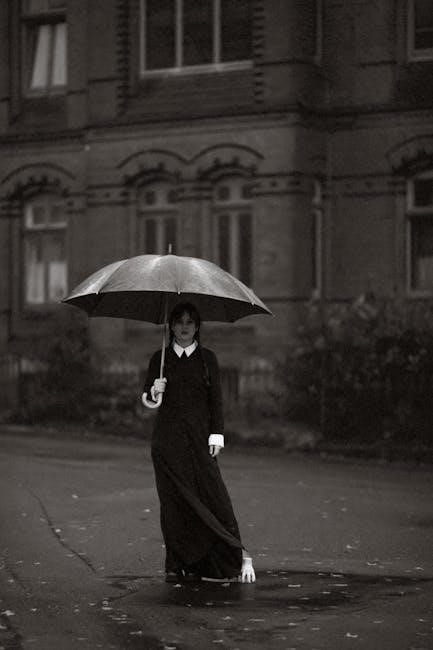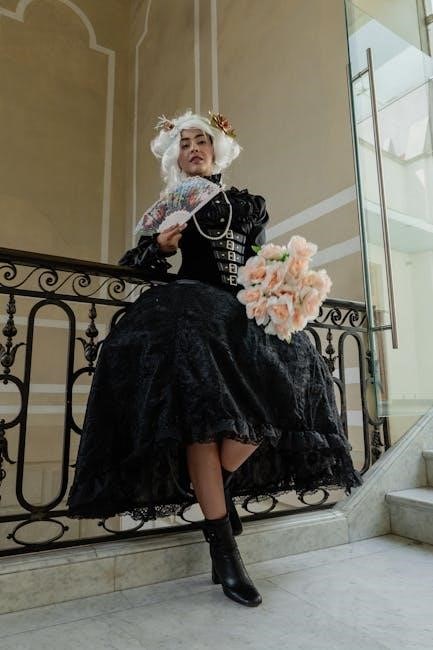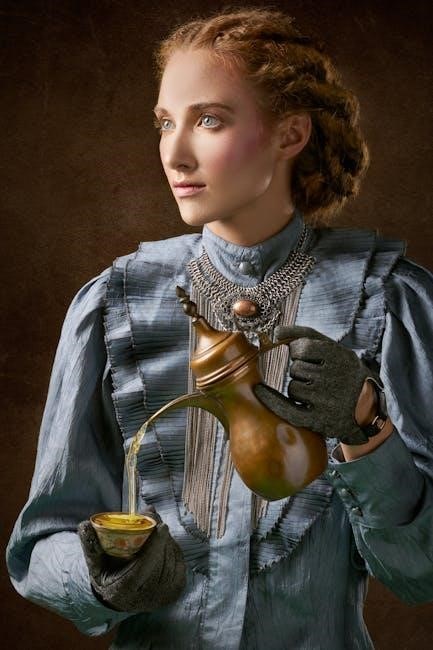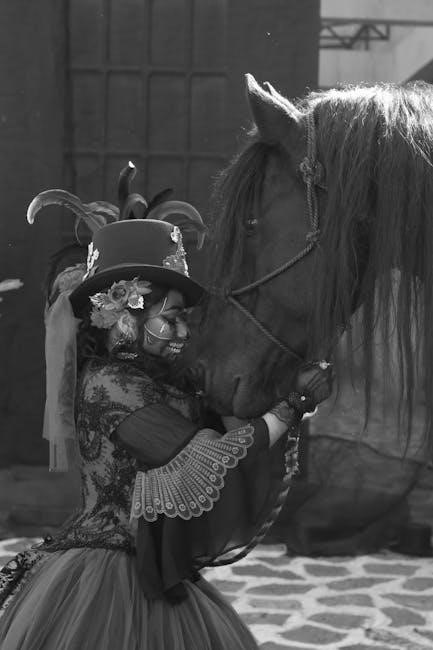Therese O’Neill’s Unmentionable offers a scandalously honest yet humorous exploration of Victorian womanhood, debunking romantic myths and revealing the unvarnished truths of 19th-century women’s lives through wit and historical insight.
Overview of the Book and Its Significance
Unmentionable: The Victorian Lady’s Guide to Sex, Marriage, and Manners by Therese O’Neill is a New York Times bestselling book that humorously explores the unspoken realities of Victorian womanhood. Blending wit with historical accuracy, it delves into topics like menstruation, marriage, and masturbation, revealing the hypocrisy and societal constraints faced by women. Illustrated with over 200 Victorian images, the book challenges romantic notions of the era, offering a fresh, honest perspective on the lives of 19th-century women, making it a significant and engaging historical resource.

Fashion and Clothing in the Victorian Era
Victorian fashion was complex, reflecting societal roles. Women wore layers of heavy fabrics and tight corsets, emphasizing modesty. The attire showcased status but restricted movement.
Undergarments and the Importance of Modesty
Victorian undergarments were designed to uphold strict modesty standards. Women wore layers of restrictive clothing, including corsets and petticoats, to conceal their bodies. The crotchless nature of some undergarments, though practical, was never openly discussed. Modesty was paramount, dictating every detail of a woman’s attire. These garments reflected societal expectations of femininity and decorum, often at the cost of comfort. Unmentionable humorously yet honestly reveals the complexities of such customs, offering insight into the unseen struggles of Victorian women.
Accessorizing: Hats, Gloves, and More
Victorian ladies adorned themselves with elaborate accessories to showcase modesty and social standing. Hats, often decorated with feathers and flowers, were essential for outdoor wear. Gloves, typically made of kid leather, were worn even indoors to maintain propriety. Parasols and fans served as both functional and fashionable items, used to convey subtle messages. These accessories were not just decorative but also symbols of a woman’s marital status and refinement, reflecting the era’s rigid societal norms. Unmentionable highlights their significance with humor and historical insight.
Hygiene and Bodily Functions
Victorian women faced unique hygiene challenges, with limited access to clean water and discreet waste disposal methods. Chamber pots and outhouses were common, yet taboo topics shrouded in secrecy and etiquette.
Managing Menstruation Discreetly
Menstruation was a deeply taboo topic in Victorian society, with women forced to conceal their cycles using rags or homemade cloths. The societal pressure to hide this natural process led to ingenious yet often unsanitary solutions, as discussed in Unmentionable. Women were expected to endure discomfort silently, with little medical guidance, as even writers without medical expertise dictated period norms. This hypocrisy reflects the era’s conflicting views on female bodily functions, as O’Neill reveals with sharp wit and historical clarity.
Bodily Functions and Victorian Etiquette
Victorian women were expected to maintain strict decorum regarding bodily functions, with activities like urination or defecation being deeply private. Chamber pots were common, but discussing such matters was taboo. Women used chemicals to mask odors, reflecting societal demands for cleanliness and modesty. Unmentionable humorously highlights these constraints, revealing how women navigated such indignities with resourcefulness and silent endurance, exposing the hypocrisy between public propriety and the messy realities of private life.

Marriage and Wedding Night Expectations
Victorian brides faced societal expectations prioritizing duty over romance, with marriage marking a significant shift from courtship to lifelong domestic responsibility, beginning with the wedding night’s initiation into matrimony.
What to Expect on Your Wedding Night
Victorian brides faced a daunting reality on their wedding night, marked by societal pressures and limited understanding of intimacy. The evening often symbolized a transition from courtship to matrimony, with brides expected to submit to their husbands’ desires. Practical advice from guides like Unmentionable revealed awkward truths, such as the prevalence of crotchless undergarments and the stark contrast between romantic ideals and the actual experience. O’Neill humorously highlights how the night often fell short of expectations, challenging romantic notions of the era.
The Role of a Victorian Wife
A Victorian wife was expected to embody modesty, obedience, and domesticity, managing the household and raising children while supporting her husband. Societal norms dictated her primary role as a caregiver and moral guardian, with limited autonomy. Unmentionable sheds light on the restrictive expectations women faced, emphasizing the stark contrast between idealized femininity and the realities of marital life, where submission and duty often overshadowed personal desires or aspirations.
Sexual Health and Myths

Unmentionable reveals Victorian myths about sexual health, including beliefs that masturbation caused illness and childbirth was a woman’s sole purpose, exposing the era’s harmful misconceptions with humor and clarity.
Contraception and Pregnancy
Unmentionable sheds light on Victorian contraception methods, such as herbs and withdrawal, often unreliable and shrouded in taboo. Pregnancy was viewed as a woman’s divine duty, with societal pressures enforcing silence on preventive measures. The book humorously yet candidly reveals how women navigated these challenges, emphasizing the era’s restrictive attitudes toward reproductive autonomy and the limited understanding of female health. O’Neill’s insights expose the harsh realities faced by women, blending history with relatable wit.
Victorian Beliefs About Masturbation
Victorian society viewed masturbation as a shameful and dangerous act, believing it could lead to insanity, illness, or even death. Women, in particular, were warned against such “self-abuse,” with societal norms enforcing silence and guilt. Unmentionable humorously critiques these myths, revealing how such beliefs were rooted in misogyny and a desire to control female autonomy. O’Neill’s candid approach highlights the absurdity of these Victorian attitudes, offering a fresh, modern perspective on a once-taboo topic.
Societal Norms and Hypocrisy
The Victorian era was marked by stark contrasts between public decorum and private realities. Women were expected to embody modesty and virtue publicly, while navigating restrictive, often oppressive private lives.
The Public vs. Private Lives of Victorian Women
Victorian women existed in a world of stark contrasts, where public decorum demanded modesty and virtue, while private lives were often marked by hidden struggles. Society expected women to embody purity and fragility, yet their private realities were fraught with challenges like menstrual hygiene, restrictive clothing, and limited autonomy. The hypocrisy of this duality was profound, as women navigated a world where their public image was meticulously curated, while their private experiences remained shrouded in silence and societal constraint.
Addressing Taboo Topics Like Spousal Abuse
Victorian society cloaked spousal abuse in silence, treating it as a private matter beyond public scrutiny. Women endured domestic violence with little legal recourse, as societal norms prioritized marital stability over their safety. Unmentionable sheds light on this hypocrisy, revealing how women were expected to endure suffering quietly, while the public facade of propriety remained intact. The book exposes the stark reality of such taboos, highlighting the duality of Victorian life and the suffocating expectations placed on women;

Therese O’Neill’s Approach to the Topic
O’Neill blends humor and candor, offering a refreshingly frank yet respectful exploration of Victorian womanhood, making the topic both accessible and engaging for modern readers.
Humor and Honesty in Historical Context
Therese O’Neill masterfully combines wit and candor to shed light on Victorian women’s lives, blending laugh-out-loud humor with unflinching honesty. By tackling taboo topics like crotchless underwear and arsenic face creams, she humanizes the era without romanticizing it. O’Neill’s approach makes the absurdities and hypocrisies of the time relatable, offering a fresh perspective that balances historical accuracy with modern sensibilities. Her unique voice ensures the narrative remains engaging while respecting the complexities of the past.
Using Illustrations to Enhance the Narrative
Nearly 200 images from Victorian publications enrich O’Neill’s narrative, providing visual context to the absurdities and realities of the era. These illustrations, ranging from corset ads to medical diagrams, add authenticity and humor, bridging the gap between past and present. They complement the text, making complex historical concepts more accessible and engaging. The visuals not only enhance the storytelling but also serve as a reminder of the societal norms and contradictions that shaped Victorian women’s lives, offering a vivid and unforgettable reading experience.
The Legacy of “Unmentionable”
Unmentionable leaves a lasting impact as a timeless commentary on Victorian society, challenging myths and exposing hypocrisies. Its blend of humor and history reshapes modern understanding of Victorian women’s lives, making it a memorable and impactful read compared to other historical works.
Reception and Impact on Modern Readers
Therese O’Neill’s Unmentionable has captivated modern readers with its unique blend of humor and historical insight. By shedding light on the often-hidden aspects of Victorian womanhood, the book has sparked conversations about gender roles and societal hypocrisy. Readers praise its ability to make history accessible and relatable, offering a fresh perspective on a bygone era.
The book’s honest portrayal of Victorian life has resonated deeply, inspiring a new appreciation for the resilience of women in the 19th century. Its modern appeal lies in its ability to connect past and present, making it a memorable and impactful read.
Comparisons to Other Historical Works
Unmentionable stands out among historical works for its candid and humorous approach, drawing comparisons to Ruth Goodman’s How to Be a Victorian. While Goodman’s work is more practical, O’Neill’s book delves deeper into taboo topics with wit and sarcasm, offering a unique perspective on Victorian life. This blend of humor and history sets it apart, making it a compelling read for those seeking an unfiltered look at the era.
Unmentionable masterfully blends humor and history, challenging romantic notions of Victorian life. O’Neill’s candid revelations about women’s experiences leave a lasting impact on modern readers.
Reflections on the Victorian Lady’s Experience
Unmentionable vividly portrays the restrictive yet resilient lives of Victorian women, exposing the stark contrast between societal expectations and personal realities. Through humor and historical accuracy, it reveals the hidden struggles of women navigating a world governed by rigid norms and hypocrisy, offering a poignant yet enlightening perspective on their enduring strength and adaptability in the face of oppressive conventions.
